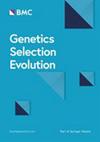Principal components-based selection criteria for genetic improvement of growth in sheep breeding programs
IF 3.1
1区 农林科学
Q1 AGRICULTURE, DAIRY & ANIMAL SCIENCE
引用次数: 0
Abstract
The objective of this study was to investigate the use of principal components (PC) as potential selection criteria to improve growth in sheep. The PC were derived from body weights of 2223 Muzaffarnagari lambs at birth, 90, 180, 270 and 360 days of age. Univariate animal models including various combinations of direct and maternal effects were fitted to the PC. Genetic correlations among PC and with body weights and estimated growth curve parameters for the Brody and Richards functions were estimated using bivariate animal models. The first three PC explained 94% of multivariate variation in body weights. PC1 contrasted lambs with larger versus smaller body weights at all postnatal ages. PC2 contrasted lambs with heavier versus lighter birth weights, with little emphasis on postnatal weights. PC3 placed positive emphasis on weights at birth and after 6 months of age but negative emphasis on weight at 3 through 9 months of age. Direct heritabilities for PC1, PC2, and PC3 were 0.19, 0.12 and 0.08, respectively. Maternal genetic and permanent environmental effects affected PC1 (0.04 and 0.08, respectively). PC2 was influenced by maternal genetic effects (0.10). Direct genetic correlations of PC1 with PC2 and PC3 were 0.48 and 0.72. The maternal genetic correlation between PC1 and PC2 was 0.97. Genetic relationships of PC1 with yearling weight and with estimates of final body weight from both growth functions exceeded 0.65. PC2 was genetically correlated with birth weight (≥ 0.64) and degree of maturity for body weight at birth (u0; ≥ 0.83). PC3 had negative genetic correlations with measures of maturing rate (~ -0.86) and with u0 ( -0.52 and -0.49), but positive correlations with final body weight (0.85 and 0.90) and time required to reach 50% of mature weight (0.83). Maternal genetic correlations of PC1 and PC2 with birth weight and u0 exceeded 0.83. We conclude that PC could be used as selection criteria in genetic improvement programs in sheep. Also, selection on PC1 and PC2 would likely be adequate to describe and improve direct and maternal genetic potentials for postnatal growth and birth weight, respectively, in Muzaffarnagari lambs.绵羊育种中生长遗传改良的主成分选择标准
本研究的目的是探讨使用主成分(PC)作为潜在的选择标准来改善绵羊的生长。PC取自2223只Muzaffarnagari羔羊出生、90、180、270和360日龄时的体重。单变量动物模型包括直接效应和母系效应的各种组合。利用双变量动物模型估计了PC与体重以及Brody和Richards函数的估计生长曲线参数之间的遗传相关性。前三个PC解释了94%的体重多变量变化。PC1对比了出生后各年龄阶段体重较大和较小的羔羊。PC2对比了出生体重较重和较轻的羔羊,很少强调出生后的体重。PC3积极强调出生时和6个月后的体重,但消极强调3至9个月的体重。PC1、PC2和PC3的直接遗传力分别为0.19、0.12和0.08。母体遗传和永久环境效应影响PC1(分别为0.04和0.08)。PC2受母体遗传效应影响(0.10)。PC1与PC2和PC3的直接遗传相关分别为0.48和0.72。PC1与PC2的亲本遗传相关为0.97。PC1与初生体重和两种生长函数估计的最终体重的遗传关系均超过0.65。PC2与出生体重(≥0.64)和出生体重成熟程度(0;≥0.83)存在遗传相关性。PC3与成熟率(~ -0.86)和u0(-0.52和-0.49)呈负相关,与末重(0.85和0.90)和达到成熟体重50%所需时间(0.83)呈正相关。PC1和PC2与出生体重和u0的亲本遗传相关均超过0.83。因此,PC可作为绵羊遗传改良的选择标准。此外,对PC1和PC2的选择可能足以描述和改善Muzaffarnagari羔羊出生后生长和出生体重的直接遗传潜力和母系遗传潜力。
本文章由计算机程序翻译,如有差异,请以英文原文为准。
求助全文
约1分钟内获得全文
求助全文
来源期刊

Genetics Selection Evolution
生物-奶制品与动物科学
CiteScore
6.50
自引率
9.80%
发文量
74
审稿时长
1 months
期刊介绍:
Genetics Selection Evolution invites basic, applied and methodological content that will aid the current understanding and the utilization of genetic variability in domestic animal species. Although the focus is on domestic animal species, research on other species is invited if it contributes to the understanding of the use of genetic variability in domestic animals. Genetics Selection Evolution publishes results from all levels of study, from the gene to the quantitative trait, from the individual to the population, the breed or the species. Contributions concerning both the biological approach, from molecular genetics to quantitative genetics, as well as the mathematical approach, from population genetics to statistics, are welcome. Specific areas of interest include but are not limited to: gene and QTL identification, mapping and characterization, analysis of new phenotypes, high-throughput SNP data analysis, functional genomics, cytogenetics, genetic diversity of populations and breeds, genetic evaluation, applied and experimental selection, genomic selection, selection efficiency, and statistical methodology for the genetic analysis of phenotypes with quantitative and mixed inheritance.
 求助内容:
求助内容: 应助结果提醒方式:
应助结果提醒方式:


